-
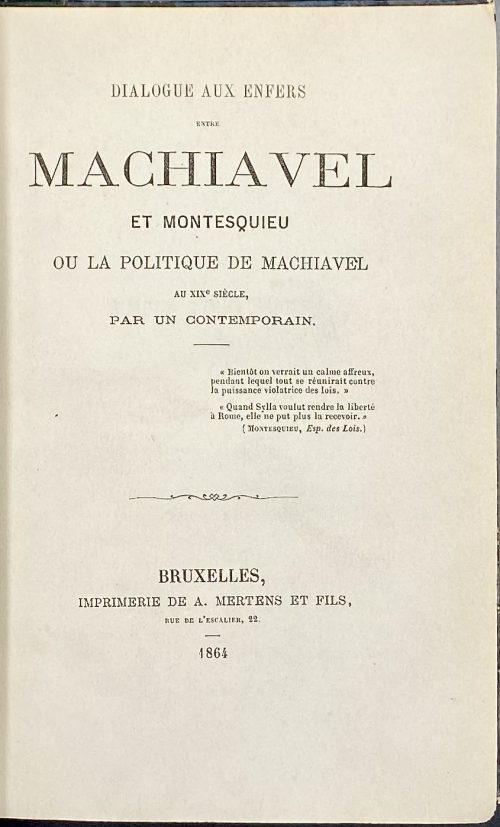 Title page: DIALOGUE AUX ENFERS | ENTRE | MACHIAVEL | ET MONTESQUIEU | OU LA POLITIQUE DE MACHIAVEL | AU XIXe SIÈCLE, | PAR UN CONTEMPORAIN. | {6 lines of citations} | ~ | BRUXELLES, | IMPRIMERIE DE A. MERTENS ET FILS, | RUE DE L’ESCALIER, 22. | – | 1864 || Description: 19 x 12.7 cm, quarter green morocco over blue marbled boards, spine with raised bands ruled in gilt, gilt fleurons in compartments, gilt lettering, marbled endpapers; three paper clippings laid in. Collation: 12mo; π5 1-2712 292; total 175 leaves. Pagination: [2] blank, [2] h.t, [2] t.p. [i] ii-iii [iv] [1] 2-337 [338] blank [2] errata]; total 350 pages. Contributors: Maurice Joly (French, 1829 – 1878) – author. Characters: Niccolò Machiavelli (Italian, 1469 – 1527) Charles Louis de Secondat, baron de La Brède et de Montesquieu (French, 1689 – 1755) The publication was funded by the author and smuggled into France. See other copies: LIB-2913.2021, LIB-1034.2016 and LIB-0460.2015. Other related objects: SVVP-0062.2021. Seller's description: [JOLY (Maurice)]: Dialogue aux enfers entre Machiavel et Montesquieu. Bruxelles, Mertens et fils, 1864 ; un volume in 12, demi-chagrin vert orné de l'époque. C'est dans ce livre que Joly écrit, au prétexte d'une discussion philosophique et politique, comment Napoléon III, selon lui, a manipulé les milieux économiques, la presse, l'opinion publique, les syndicats, les milieux ouvriers, le peuple, etc., pour établir un pouvoir politique fort, ce qui lui valut un séjour de 15 mois à la prison Sainte-Pélagie à Paris.
Title page: DIALOGUE AUX ENFERS | ENTRE | MACHIAVEL | ET MONTESQUIEU | OU LA POLITIQUE DE MACHIAVEL | AU XIXe SIÈCLE, | PAR UN CONTEMPORAIN. | {6 lines of citations} | ~ | BRUXELLES, | IMPRIMERIE DE A. MERTENS ET FILS, | RUE DE L’ESCALIER, 22. | – | 1864 || Description: 19 x 12.7 cm, quarter green morocco over blue marbled boards, spine with raised bands ruled in gilt, gilt fleurons in compartments, gilt lettering, marbled endpapers; three paper clippings laid in. Collation: 12mo; π5 1-2712 292; total 175 leaves. Pagination: [2] blank, [2] h.t, [2] t.p. [i] ii-iii [iv] [1] 2-337 [338] blank [2] errata]; total 350 pages. Contributors: Maurice Joly (French, 1829 – 1878) – author. Characters: Niccolò Machiavelli (Italian, 1469 – 1527) Charles Louis de Secondat, baron de La Brède et de Montesquieu (French, 1689 – 1755) The publication was funded by the author and smuggled into France. See other copies: LIB-2913.2021, LIB-1034.2016 and LIB-0460.2015. Other related objects: SVVP-0062.2021. Seller's description: [JOLY (Maurice)]: Dialogue aux enfers entre Machiavel et Montesquieu. Bruxelles, Mertens et fils, 1864 ; un volume in 12, demi-chagrin vert orné de l'époque. C'est dans ce livre que Joly écrit, au prétexte d'une discussion philosophique et politique, comment Napoléon III, selon lui, a manipulé les milieux économiques, la presse, l'opinion publique, les syndicats, les milieux ouvriers, le peuple, etc., pour établir un pouvoir politique fort, ce qui lui valut un séjour de 15 mois à la prison Sainte-Pélagie à Paris. -
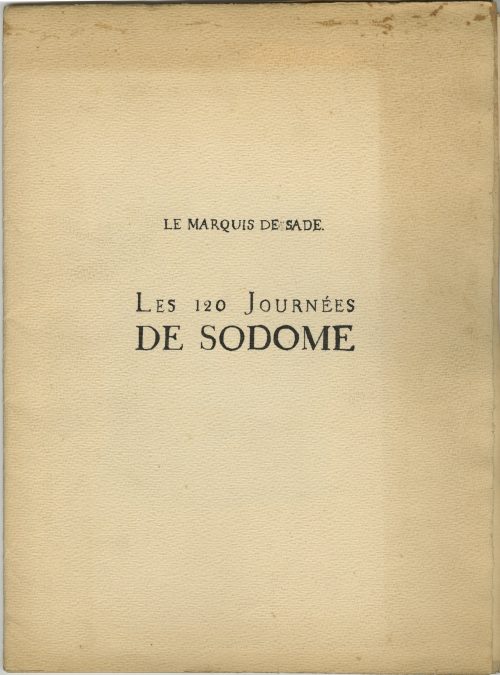 A set of sixteen pen and ink wash drawings on wove paper by an anonymous artist after lithographs by André Collot, who illustrated the 1935 edition of Les 120 journées de Sodome, ou l’école du libertinage, by the Marquis de Sade, based on the original autograph manuscript by Maurice Heine. The set is housed in a rough texture paper folder with an ink manuscript to the front: LE MARQUIS DE SADE. | Les 120 journées | DE SODOME || Size: 340 x 250 mm (folder); 335 x 252 (sheet); approx. 160 x 110 (image). Contributors: Donatien Alphonse François, Marquis de Sade (French, 1740 – 1814) – author. Maurice Heine (French, 1884 – 1940) – publisher of the original Les 120 journées. André Collot (French, 1897-1976) – artist of the original illustrations for the 1935 edition. This set was produced by an anonymous artist from the bohemian Montmartre, Montparnasse, or the School of Fine Arts, close to the booksellers', by demand of an excentric bibliophile, at about the same time. Collot's illustrations can be found at www.honesterotica.com.
A set of sixteen pen and ink wash drawings on wove paper by an anonymous artist after lithographs by André Collot, who illustrated the 1935 edition of Les 120 journées de Sodome, ou l’école du libertinage, by the Marquis de Sade, based on the original autograph manuscript by Maurice Heine. The set is housed in a rough texture paper folder with an ink manuscript to the front: LE MARQUIS DE SADE. | Les 120 journées | DE SODOME || Size: 340 x 250 mm (folder); 335 x 252 (sheet); approx. 160 x 110 (image). Contributors: Donatien Alphonse François, Marquis de Sade (French, 1740 – 1814) – author. Maurice Heine (French, 1884 – 1940) – publisher of the original Les 120 journées. André Collot (French, 1897-1976) – artist of the original illustrations for the 1935 edition. This set was produced by an anonymous artist from the bohemian Montmartre, Montparnasse, or the School of Fine Arts, close to the booksellers', by demand of an excentric bibliophile, at about the same time. Collot's illustrations can be found at www.honesterotica.com. -
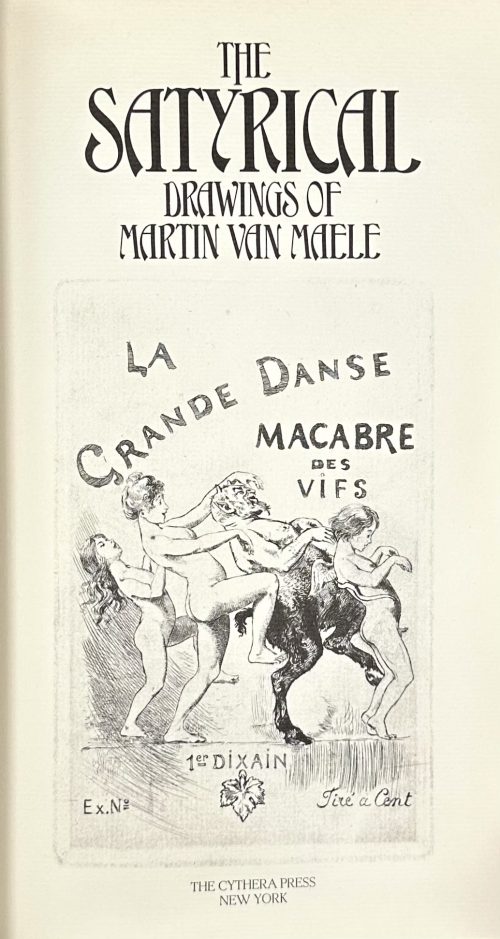 Hardcover volume 28.5 x 19 cm, bound in brown wrinkled buckram with framed gilt lettering and fleurons to front and framed gilt lettering to spine, in a pictorial dust jacket, green and yellow floral diaper endpapers, printed on laid paper, bottom and outer margins untrimmed. Collation: Eight unnumbered pages of text in English, incl. bibliography, plus 45 unnumbered leaves of plates (photomechanical) with captions in French. Facsimile reproduction of the published in ca. 1907-1908 ‘La grande danse macabre des vifs’, which can be loosely translated as ‘The great strange dance of life’ or ‘The great dance of death by the living’. Title-page: THE | SATYRICAL | DRAWINGS OF | MARTIN VAN MAELE | {vignette} | THE CYTHERA PRESS NEW YORK || SELECTED BIBLIOGRAPHY OF MAURICE FRANÇOIS ALFRED MARTIN VAN MAËLE [MARTIN VAN MAËLE] (FRENCH, 1863 – 1926) (ANONYMOUS). Sweet Seventeen. — Paris: Charles Carrington, 1910. ANSON, MARGUERITE. Une Société de flagellantes. — Paris: Charles Carrington. 1902. 31 illustrations by Van Maele and A. Lambrecht. Translation of The Merry Order of St. Bridget. APULEUS, LUCIUS. Les Métamorphoses, ou l’âne d'or. — Paris: Charles Carrington, 1905. Translation of The Golden Ass. The same Van Maele plates were probably used by the publisher for his English translation of the same work (Paris, 1904). ARETINO, PIETRO. Les Dialogues. 2 volumes. — Paris: Au Cabinet du Livre. 1927. Only the textual illustrations are by Van Maele. The other plates are by Viset. This is believed to be the Iast book that Van Maele illustrated. DESROIX, JACQUES. La Gynécocratte. — Paris: Charles Carrington, 1902. Translation of Gynecocracy. FRANCE, ANATOLE. Thaïs. — Paris: Charles Carrington, 1901. English translation. JUSANGE. PIERRE DE. La Comtesse au foulet. — Paris: Collection des Orties Blanches, s.d. SACHER-MASOCH. La Vénus a la fourrure. — Paris: Charles Carrington, 1902. VAN MAELE, MARTIN. La Grande Danse macabre des vifs. — Paris: Charles Carrington, ca. 1907-8. VERLAINE, PAUL. La Trilogie érotique. — Paris: Charles Carrington, 1907. Reprinted, Brussels, 1931. The original edition is rare. VILLIOT, JEAN DE. Camille et moi. — Paris: Charles Carrington, 1904. Translation of Frank and I. VILLIOT, JEAN DE. Dix-sept ans. — Paris: Librairie des Bibliophiles Parisiens, Charles Carrington, 1905. Translation of Sweet Seventeen. VILLIOT, JEAN DE. La Flagellation amoureuse. — Paris: Charles Carrington. 1904. VILLIOT, JEAN DE. La Flagellation des femmes en Allemagne. — Paris: Charles Carrington. 1901. Translation of Nell in Bridewell. VILLIOT, JEAN DE. Volées de bois vert. — Paris: Librairie des Bibliophiles Parisiens, Charles Carrington, 1905. (ANONYMOUS): Flèches de plomb. BAUDELAIRE, CHARLES. Les Fleurs du mal. BERANGER. Chansons érotiques. CHODER LOS DE LACLOS. Les Liaisons dangereuses. — Paris: 1908. GAUTIER, THEOPHILE. Lettre au Président. HARAUCOURT. Légende des sexes. — Paris, 1908. MICHELET, JULES. La Sorcière. — Paris, 1911.
Hardcover volume 28.5 x 19 cm, bound in brown wrinkled buckram with framed gilt lettering and fleurons to front and framed gilt lettering to spine, in a pictorial dust jacket, green and yellow floral diaper endpapers, printed on laid paper, bottom and outer margins untrimmed. Collation: Eight unnumbered pages of text in English, incl. bibliography, plus 45 unnumbered leaves of plates (photomechanical) with captions in French. Facsimile reproduction of the published in ca. 1907-1908 ‘La grande danse macabre des vifs’, which can be loosely translated as ‘The great strange dance of life’ or ‘The great dance of death by the living’. Title-page: THE | SATYRICAL | DRAWINGS OF | MARTIN VAN MAELE | {vignette} | THE CYTHERA PRESS NEW YORK || SELECTED BIBLIOGRAPHY OF MAURICE FRANÇOIS ALFRED MARTIN VAN MAËLE [MARTIN VAN MAËLE] (FRENCH, 1863 – 1926) (ANONYMOUS). Sweet Seventeen. — Paris: Charles Carrington, 1910. ANSON, MARGUERITE. Une Société de flagellantes. — Paris: Charles Carrington. 1902. 31 illustrations by Van Maele and A. Lambrecht. Translation of The Merry Order of St. Bridget. APULEUS, LUCIUS. Les Métamorphoses, ou l’âne d'or. — Paris: Charles Carrington, 1905. Translation of The Golden Ass. The same Van Maele plates were probably used by the publisher for his English translation of the same work (Paris, 1904). ARETINO, PIETRO. Les Dialogues. 2 volumes. — Paris: Au Cabinet du Livre. 1927. Only the textual illustrations are by Van Maele. The other plates are by Viset. This is believed to be the Iast book that Van Maele illustrated. DESROIX, JACQUES. La Gynécocratte. — Paris: Charles Carrington, 1902. Translation of Gynecocracy. FRANCE, ANATOLE. Thaïs. — Paris: Charles Carrington, 1901. English translation. JUSANGE. PIERRE DE. La Comtesse au foulet. — Paris: Collection des Orties Blanches, s.d. SACHER-MASOCH. La Vénus a la fourrure. — Paris: Charles Carrington, 1902. VAN MAELE, MARTIN. La Grande Danse macabre des vifs. — Paris: Charles Carrington, ca. 1907-8. VERLAINE, PAUL. La Trilogie érotique. — Paris: Charles Carrington, 1907. Reprinted, Brussels, 1931. The original edition is rare. VILLIOT, JEAN DE. Camille et moi. — Paris: Charles Carrington, 1904. Translation of Frank and I. VILLIOT, JEAN DE. Dix-sept ans. — Paris: Librairie des Bibliophiles Parisiens, Charles Carrington, 1905. Translation of Sweet Seventeen. VILLIOT, JEAN DE. La Flagellation amoureuse. — Paris: Charles Carrington. 1904. VILLIOT, JEAN DE. La Flagellation des femmes en Allemagne. — Paris: Charles Carrington. 1901. Translation of Nell in Bridewell. VILLIOT, JEAN DE. Volées de bois vert. — Paris: Librairie des Bibliophiles Parisiens, Charles Carrington, 1905. (ANONYMOUS): Flèches de plomb. BAUDELAIRE, CHARLES. Les Fleurs du mal. BERANGER. Chansons érotiques. CHODER LOS DE LACLOS. Les Liaisons dangereuses. — Paris: 1908. GAUTIER, THEOPHILE. Lettre au Président. HARAUCOURT. Légende des sexes. — Paris, 1908. MICHELET, JULES. La Sorcière. — Paris, 1911. -
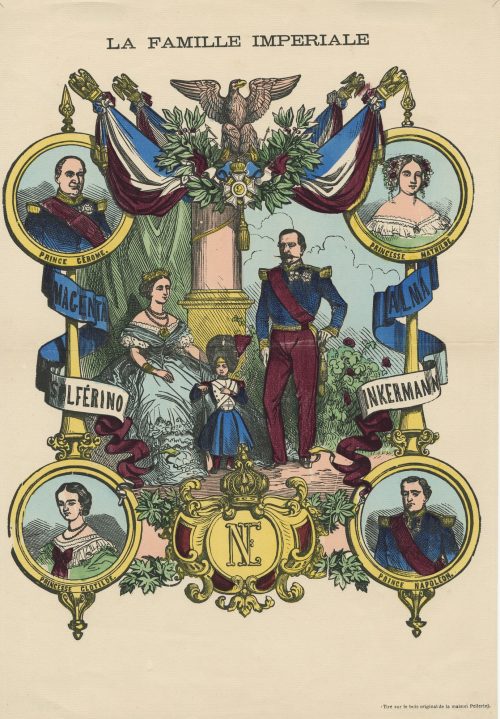 Hand-coloured woodcut on laid paper, 422 x 294 mm; black ink stamp “5307” to reverse, centrefold. Top center: "LA FAMILLE IMPERIALE"; Bottom right: "(Tire sur le bois original de maison Pellerin)". Image: Napoléon III, Empress Eugenie, and Prince Imperial Louis-Napoléon as a child surrounded with four lettered medallions: “PRINCE GÉROME”, “PRINCESSE MATHILDE”, “PRINCESSE CLOTILDE”, and “PRINCE NAPOLÉON”; ribbons lettered: “MAGENTA”, SOLFERINO”, “ALMA”, and “INKERMANN” around heraldic spears; coat of arms with imperial monogram between Princesse Clotilde and Prince Napoléon. Publisher/printer: Jean Charles Pellerin (French, 1756 – 1836). Battle of Magenta : 4 June 1859, against the Austrians. Battle of Solferino : 24 June 1859, against the Austrians. Battle of the Alma : 20 September 1854 (Crimean War) Battle of Inkerman : 5 November 1854 (Crimean War) Characters: Napoleon III [Charles-Louis Napoléon Bonaparte] (French, 1808 – 1873) Eugénie de Montijo [L'impératrice Eugénie] (Spanish-French, 1826 – 1920) Napoléon, Prince Imperial (Napoléon Eugène Louis Jean Joseph Bonaparte] (French, 1856 – 1879) Napoléon-Jérôme Bonaparte [Prince Jérôme] (French, 1822 – 1891) Mathilde Bonaparte [Princess Mathilde] (French, 1820 – 1904) Marie-Clotilde de Savoie [Princesse Clotilde] (French, 1843 – 1911)
Hand-coloured woodcut on laid paper, 422 x 294 mm; black ink stamp “5307” to reverse, centrefold. Top center: "LA FAMILLE IMPERIALE"; Bottom right: "(Tire sur le bois original de maison Pellerin)". Image: Napoléon III, Empress Eugenie, and Prince Imperial Louis-Napoléon as a child surrounded with four lettered medallions: “PRINCE GÉROME”, “PRINCESSE MATHILDE”, “PRINCESSE CLOTILDE”, and “PRINCE NAPOLÉON”; ribbons lettered: “MAGENTA”, SOLFERINO”, “ALMA”, and “INKERMANN” around heraldic spears; coat of arms with imperial monogram between Princesse Clotilde and Prince Napoléon. Publisher/printer: Jean Charles Pellerin (French, 1756 – 1836). Battle of Magenta : 4 June 1859, against the Austrians. Battle of Solferino : 24 June 1859, against the Austrians. Battle of the Alma : 20 September 1854 (Crimean War) Battle of Inkerman : 5 November 1854 (Crimean War) Characters: Napoleon III [Charles-Louis Napoléon Bonaparte] (French, 1808 – 1873) Eugénie de Montijo [L'impératrice Eugénie] (Spanish-French, 1826 – 1920) Napoléon, Prince Imperial (Napoléon Eugène Louis Jean Joseph Bonaparte] (French, 1856 – 1879) Napoléon-Jérôme Bonaparte [Prince Jérôme] (French, 1822 – 1891) Mathilde Bonaparte [Princess Mathilde] (French, 1820 – 1904) Marie-Clotilde de Savoie [Princesse Clotilde] (French, 1843 – 1911) -
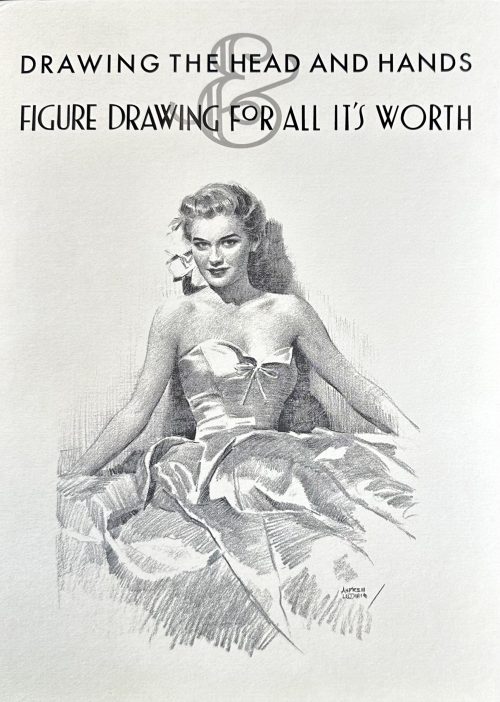 Cardboard box 32 x 23.7 cm with lettering and vignette to front, lettering to spine, and Loomis facsimile and Titan publisher's barcode label to back.
Cardboard box 32 x 23.7 cm with lettering and vignette to front, lettering to spine, and Loomis facsimile and Titan publisher's barcode label to back.- Title-page: Drawing | THE HEAD AND HANDS | BY | ANDREW LOOMIS | {vignette} ||
- Title-page: FIGURE DRAWING | FOR ALL IT'S WORTH | ANDREW LOOMIS ||
-
 Iron tsuba of mokko form decorated with encircled family crests in low relief carving; niku from 3.0 mm in the centre to 4.0 mm at rim and full 1 mm raised uchikaeshi-mimi. Nobuie [信家] signature (hanare-mei) to the left of nakago-ana; on the reverse, to the right of nakago-ana, the inscription reads “62”, which may be how old the master was at the age of making the tsuba. Pewter or lead plugged hitsuana. In a wooden box, in a custom pouch. Size: H: 80 mm, W: 75, Th(c): 3.1 mm, Th(r): 4.0 mm Weight: 103.5 g
Iron tsuba of mokko form decorated with encircled family crests in low relief carving; niku from 3.0 mm in the centre to 4.0 mm at rim and full 1 mm raised uchikaeshi-mimi. Nobuie [信家] signature (hanare-mei) to the left of nakago-ana; on the reverse, to the right of nakago-ana, the inscription reads “62”, which may be how old the master was at the age of making the tsuba. Pewter or lead plugged hitsuana. In a wooden box, in a custom pouch. Size: H: 80 mm, W: 75, Th(c): 3.1 mm, Th(r): 4.0 mm Weight: 103.5 gSigned: Nobuie [信家] / 62
Probably the work of Shodai Nobuie (c. 1580).
Tokubetsu hozon certificate № 2002993 of the N.B.T.H.K., dated January 15, 2016. NOBUIE TSUBA by Steve Waszak The iron tsuba made by the two early Nobuie masters are regarded as the greatest sword guards ever made across hundreds of years of Japanese history. Only a small handful of other smiths' names are even mentioned in the same breath as that of Nobuie. Despite the well-deserved fame of the Nobuie name, virtually nothing is known with certainty about the lives of the two men who made the pieces carrying this name. They are thought to have been men of Owari Province, with the Nidai Nobuie also spending time in Aki Province at the end of the Momoyama Period. Two Nobuie tsubako are recognized. The man whom most consider to have been the Shodai signed his sword guards with finer and more elegantly inscribed characters than the smith seen by most as the Nidai. The term used to describe the mei of the Shodai is "hanare-mei" or "ga-mei," while that used to characterize the signature of the Nidai is "futoji-mei" or "chikara-mei." These terms refer to the fineness and grace of the Shodai's signature and the relatively more powerfully inscribed characters of the Nidai's. The Shodai is thought to have lived during the Eiroku and Tensho eras in the latter part of the 16th century, while the Nidai's years are considered to have been from Tensho into the Genna era. This locates both smiths well within the Golden Age of tsuba artists -- the Momoyama Period. Nobuie tsuba are esteemed and celebrated for the extraordinary beauty of their iron. The combination of the forging of the metal, the surface treatment by tsuchime and yakite married to powerfully expressive carving, the masterful manipulation of form, mass and shape, and the colour and patina of the iron makes Nobuie sword guards not only unique in the world of tsuba, but the greatest of the great. The sword guard here is a Shodai-made masterwork, done in mokko-gata form, a shape the early Nobuie smiths mastered to a degree unmatched by any others. The expanding of the mass of the tsuba from the seppa-dai to the mimi, increasing by 50% from the centre of the guard to the rim, creates a sense of exploding energy, which is then contained by the uchikaeshi-mimi, yielding a lightning-in-a-bottle effect of captured energy. The hammering the master has employed to finish the surface is subtle and sensitive, achieving a resonant profundity, and the deep blue-black colour -- augmented by a lustrous patina -- leaves the tsuba to positively glow in one's hand. In this piece, Nobuie has used a motif of several kamon, or family crests, each carved only lightly on the surface in a loose ring around the nakago-ana. Due to the shallow depth of this carving, together with the tsuchime finish of the plate, the effect is to leave the kamon with a sort of weathered appearance, recalling the prime aesthetic values of sabi and wabi, which had great circulation in the Tea Culture so ascendant in the Momoyama years. However, the effects of sabi and wabi expressed in the treatment described above are amplified and deepened by the color and patina of the iron, thereby adding yet another aesthetic value -- yuugen -- which is linked with the abiding mystery of the universe and one more — mono no aware — which alludes to the pathos of life's experiences and transitory nature. In short, this Nobuie tsuba joins poetry with power and therein exemplifies the unrivalled brilliance of Nobuie workmanship. -
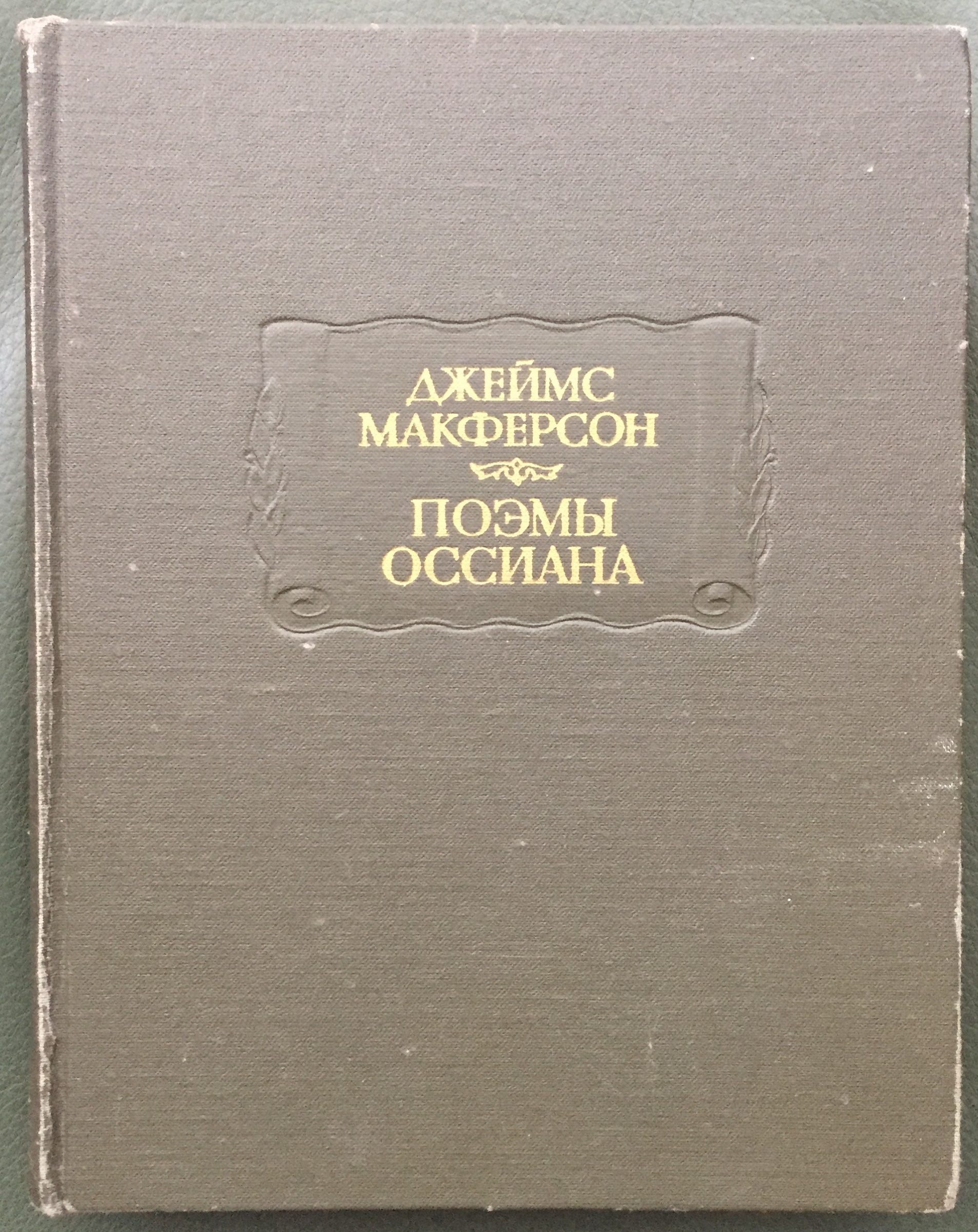 Title (black and red): ДЖЕЙМС МАКФЕРСОН | ПОЭМЫ ОССИАНА | {device} | ИЗДАНИЕ ПОДГОТОВИЛ | Ю. Д. ЛЕВИН | ИЗДАТЕЛЬСТВО «НАУКА» | ЛЕНИНГРАДСКОЕ ОТДЕЛЕНИЕ | ЛЕНИНГРАД | 1983 || Title verso: РЕДАКЦИОННАЯ КОЛЛЕГИЯ СЕРИИ | «ЛИТЕРАТУРНЫЕ ПАМЯТНИКИ» | (list of names) | Ответственный редактор | академик М. П. АЛЕКСЕЕВ (in frame) | Редактор перевода | Э. Л. ЛИНЕЦКАЯ. Frontispiece (black and red): JAMES MACPHERSON | THE POEMS OF OSSIAN | {device} || Print run: 30,000 copies. Collation: 8vo; [1]8 2-378. Pagination: [1, 2] – serial h.t. / frontis.] [3, 4] – t.p. / editorial board] [portrait / blank] [5, 6] – original t.p. fac-simile / text, 7–589 [590] – imprint, [2] – advert.; 3 leaves of plates. Binding: serial green buckram blind-stamped with a scroll adorned with gold lettering to board and spine. Джеймс Макферсон. Поэмы Оссиана. Ю. Д. Левин. Э. Л. Линецкая.
Title (black and red): ДЖЕЙМС МАКФЕРСОН | ПОЭМЫ ОССИАНА | {device} | ИЗДАНИЕ ПОДГОТОВИЛ | Ю. Д. ЛЕВИН | ИЗДАТЕЛЬСТВО «НАУКА» | ЛЕНИНГРАДСКОЕ ОТДЕЛЕНИЕ | ЛЕНИНГРАД | 1983 || Title verso: РЕДАКЦИОННАЯ КОЛЛЕГИЯ СЕРИИ | «ЛИТЕРАТУРНЫЕ ПАМЯТНИКИ» | (list of names) | Ответственный редактор | академик М. П. АЛЕКСЕЕВ (in frame) | Редактор перевода | Э. Л. ЛИНЕЦКАЯ. Frontispiece (black and red): JAMES MACPHERSON | THE POEMS OF OSSIAN | {device} || Print run: 30,000 copies. Collation: 8vo; [1]8 2-378. Pagination: [1, 2] – serial h.t. / frontis.] [3, 4] – t.p. / editorial board] [portrait / blank] [5, 6] – original t.p. fac-simile / text, 7–589 [590] – imprint, [2] – advert.; 3 leaves of plates. Binding: serial green buckram blind-stamped with a scroll adorned with gold lettering to board and spine. Джеймс Макферсон. Поэмы Оссиана. Ю. Д. Левин. Э. Л. Линецкая. -
 Iron tsuba with brown patina in mokkō-gata form with woven design. Size: 72 x 67 x 5 mm.
Iron tsuba with brown patina in mokkō-gata form with woven design. Size: 72 x 67 x 5 mm. -
 L'incendie de Hôtel de Ville (24 mai 1871). A woodcut by Provost; printed by Imp. Charaire et fils; F. Roy, éditier.
L'incendie de Hôtel de Ville (24 mai 1871). A woodcut by Provost; printed by Imp. Charaire et fils; F. Roy, éditier. -
 Iron tsuba of round form with slanting rays of light (shakoh) Christian motif (Jesuit’s IHS symbol) in openwork (sukashi). Traditional description of this kind of design is called “tokei”, or “clock gear”. Signed: On the face: Bushu ju Akasaka; On the back: Tadatoki Saku [Made by Tadatoki, resident of Bushu]. Probably, 4th generation of Akasaka School master Tadatoki (忠時), who died in 1746. Akasaka School. Edo period, first half of the 18th century. Size: 79.8 x 78.5 x 6.5 mm
Iron tsuba of round form with slanting rays of light (shakoh) Christian motif (Jesuit’s IHS symbol) in openwork (sukashi). Traditional description of this kind of design is called “tokei”, or “clock gear”. Signed: On the face: Bushu ju Akasaka; On the back: Tadatoki Saku [Made by Tadatoki, resident of Bushu]. Probably, 4th generation of Akasaka School master Tadatoki (忠時), who died in 1746. Akasaka School. Edo period, first half of the 18th century. Size: 79.8 x 78.5 x 6.5 mm -
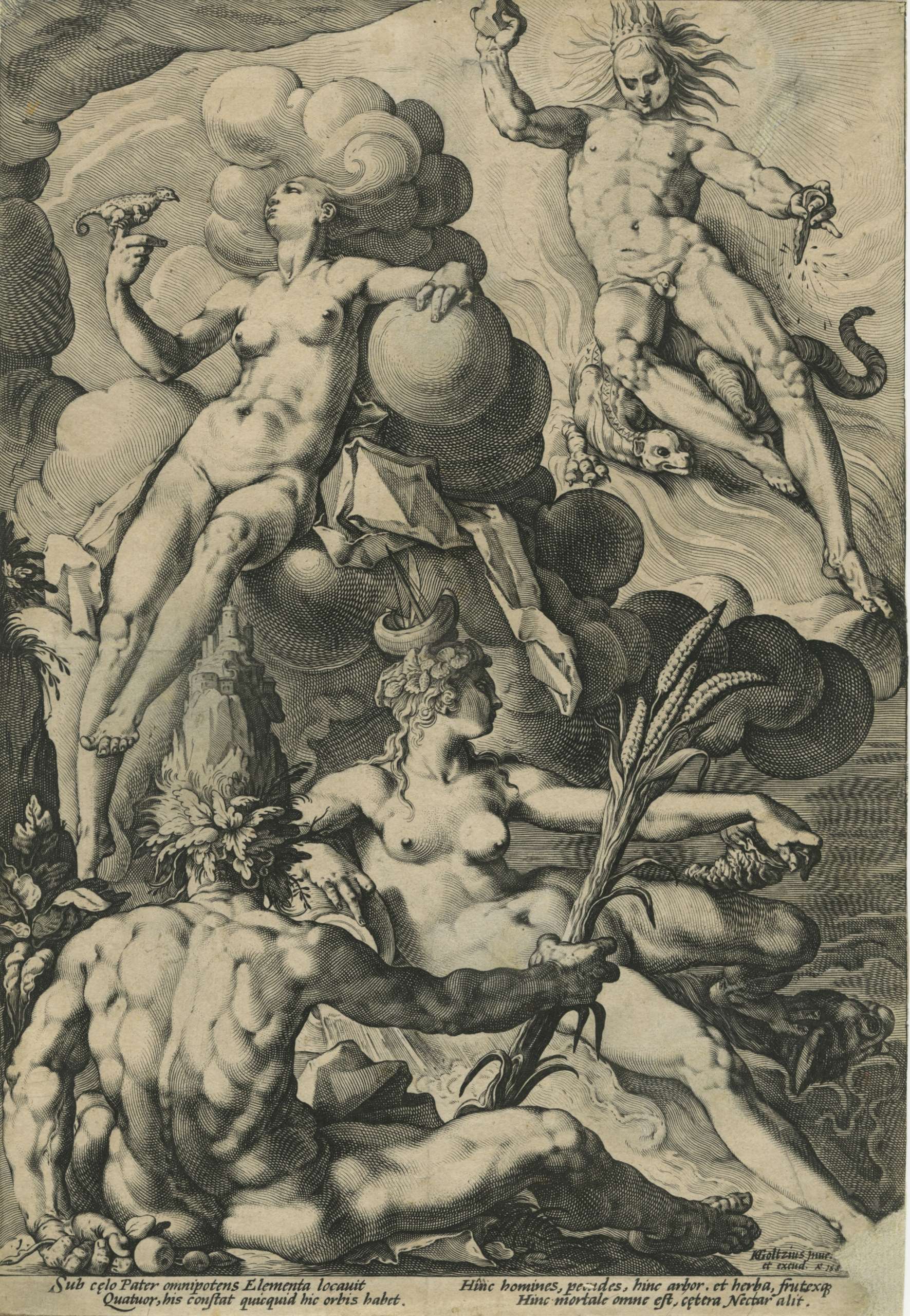
The Four Elements by Jacob Matham (Netherlandish, Haarlem 1571–1631 Haarlem) after Hendrick Goltzius (Netherlandish, Mühlbracht 1558–1617 Haarlem). Engraving on copper, printed on laid paper, 1588.
Dimensions: 298 mm × 206 mm.
-
 Iron tsuba of half round and half lobed (chrysanthemoid) form decorated with plants and family crests (mon) in cast brass inlay (suemon-zōgan), and scattered brass dots inlay (ten-zōgan); brass wire inlay outlining the rim, seppa-dai, and hitsu-ana (scalloped wire) on both sides. Surface treated with hummer punch marks. The chrysanthemoid half of the plate chiseled with thin shallow grooves, outlining the petals. Copper sekigane. On the face the inlay represents: mandarin orange (tachibana), half karahana, encircled bellflower, and four encircled three-stipe family crest (mitsubiki-mon of Sakuma and Abe clans, and some others). On the reverse the design is similar but two of the mitsubiki-mon symbols replaced with two comb-shaped Genji-mon ideographs. Ōnin school. The end of mid-Muromachi period, beginning of the 16th century. Size: 74.3 x 72.7 x 2.4 mm.
Iron tsuba of half round and half lobed (chrysanthemoid) form decorated with plants and family crests (mon) in cast brass inlay (suemon-zōgan), and scattered brass dots inlay (ten-zōgan); brass wire inlay outlining the rim, seppa-dai, and hitsu-ana (scalloped wire) on both sides. Surface treated with hummer punch marks. The chrysanthemoid half of the plate chiseled with thin shallow grooves, outlining the petals. Copper sekigane. On the face the inlay represents: mandarin orange (tachibana), half karahana, encircled bellflower, and four encircled three-stipe family crest (mitsubiki-mon of Sakuma and Abe clans, and some others). On the reverse the design is similar but two of the mitsubiki-mon symbols replaced with two comb-shaped Genji-mon ideographs. Ōnin school. The end of mid-Muromachi period, beginning of the 16th century. Size: 74.3 x 72.7 x 2.4 mm. -

Very fine iron plate well hammered and turned, tapering and rolling to the rounded edge. Tsuba of a cross-form mokko shape (juji-mokko-gata) decorated with spider web inlaid in gold on both sides. The face is carved with a silver-damascened spider holding a gold-damascened butterfly (nunome-zōgan). Kozuka and kogai hitsu-ana of inome (boar's eye) form. The udenuki ana may be of purely decorative purpose.
Signed: Yatsushiro [八代] Jingo Saku [甚吾作], a signature of Chisokutei Amatsune, one of the last Jingo masters.
Late Edo period, Tenpō era, 1830-1844.Size: Height: 77.5 mm; Width: 72.8 mm; Thickness: 4.1 mm; Weight: 141 g.
In a custom wooden box.
Here is what Markus Sesko wrights in his book The Japanese toso-kinko Schools, 2012, on page 374:An artist who worked in the style of the Shimizu-Jingo school was Chisokutei Amatsune (知足亭天常). He was actually a samurai from Yatsushiro who made tsuba as a sideline. An extant old hakogaki of one of his pieces mentions that he died in Edo in the sixth month of An'ei eight (1779) at the age of 73. But the era of An'ei is probably wrong because Chikokutei (sic) is today dated by most experts around Tenpō (1830-1844). His relationships with the Shimizu school or under which Jingo master he had studied are unknown. From the point of view of production time and the finishing of nakago-ana, he is rather associated with the 5th and last gen. Shigenaga who died in the seventh year of Kaei (1854). A peculiarity of Chisokutei was that he signed his Jingo copies with "Yatsushiro Jingo Saku" ([八代甚吾作) but added the small syllable "chi" (チ) or the character "Chi" (知) for "Chisokutei" to identify them as copies.
No longer available. -

Pro-tech Walter Brend custom switchblade knife with solid 416 stainless steel frame, amber jigged bone inlays, mirror polished 154-CM blade.
Size: 94 mm (closed); 168 mm (opned); 74 mm blade)
-
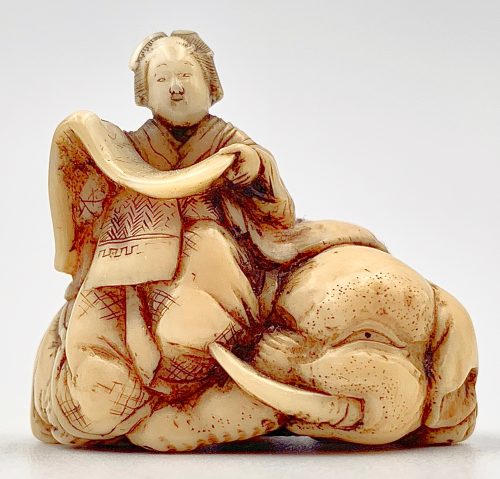 Netsuke of Kimi no Eguchi on a recumbent elephant. Signed: Toun. Circa 1850. 33.7 x 30.8 x 22.7 mm. The Courtesan Eguchi no kimi as Fugen, Bodhisattva of Universal Wisdom (Eguchi no kimi mitate Fugen Bosatsu). The imagery satirizes the Buddhist bodhisattva Fugen, whose iconographic mount is an elephant, by replacing the deity with a beautifully coiffed modern courtesan. Such a visual pun (mitate) was an artistic trope, popular in the Edo period. Provenance: Charles Ephrussi (1849-1905) acquired in the 1870s; a wedding gift in 1898 to his cousin Ritter Viktor von Ephrussi (1860-1945) and Baroness Emilie (Emmy) Schey von Koromla (1879-1938); retrieved post-war by their daughter Elizabeth de Waal (1899-1991); given by her to her brother Ignaz (Iggie) Ephrussi (1906-1994), Tokyo; bequeathed by him to his great-nephew Edmund de Waal (born 1964), London, author of "The Hare with Amber Eyes: a hidden inheritance". London / New York: Chatto & Windus / Farrar, Straus & Giroux. ISBN 978-0099539551. https://en.wikipedia.org/wiki/Charles_Ephrussi. https://en.wikipedia.org/wiki/Ephrussi_family. https://en.wikipedia.org/wiki/Edmund_de_Waal.
Netsuke of Kimi no Eguchi on a recumbent elephant. Signed: Toun. Circa 1850. 33.7 x 30.8 x 22.7 mm. The Courtesan Eguchi no kimi as Fugen, Bodhisattva of Universal Wisdom (Eguchi no kimi mitate Fugen Bosatsu). The imagery satirizes the Buddhist bodhisattva Fugen, whose iconographic mount is an elephant, by replacing the deity with a beautifully coiffed modern courtesan. Such a visual pun (mitate) was an artistic trope, popular in the Edo period. Provenance: Charles Ephrussi (1849-1905) acquired in the 1870s; a wedding gift in 1898 to his cousin Ritter Viktor von Ephrussi (1860-1945) and Baroness Emilie (Emmy) Schey von Koromla (1879-1938); retrieved post-war by their daughter Elizabeth de Waal (1899-1991); given by her to her brother Ignaz (Iggie) Ephrussi (1906-1994), Tokyo; bequeathed by him to his great-nephew Edmund de Waal (born 1964), London, author of "The Hare with Amber Eyes: a hidden inheritance". London / New York: Chatto & Windus / Farrar, Straus & Giroux. ISBN 978-0099539551. https://en.wikipedia.org/wiki/Charles_Ephrussi. https://en.wikipedia.org/wiki/Ephrussi_family. https://en.wikipedia.org/wiki/Edmund_de_Waal. -
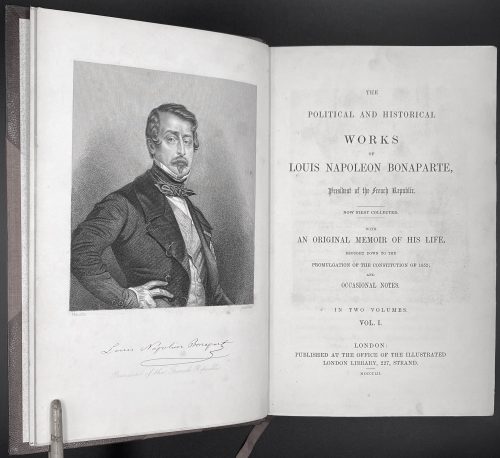 [Bonaparte, Louis Napoleon]. The Political and Historical Works of Louis Napoleon Bonaparte, President of the French Republic, Now First Collected With An Original Memoir of His Life, Brought Down to the Promulgation of the Constitution of 1852; and Occasional Notes, Complete in Two Volumes. London: Illustrated London Library, MDCCCLII [1852]. Collation: Vol. 1: [i-v] vi [vii-viii (blank)] [1] 2-462 [463,464 (blank)]; Vol. 2: [1-3] 4-439 [440]. Size: 22.8 x 14.8 cm (8vo), each. Binding: hardcover; half red morocco and cloth boards, five raised bands, gilt title and decoration, top edge gilt. Frontispiece portrait of Louis Napoleon Bonaparte in Vol. 1. Condition: Very good, rubbing to outer joints, leather corners, faint foxing to endpapers, ownership signature on half-title. Internally bright and unmarked. In binding by Brentano's, New York.
[Bonaparte, Louis Napoleon]. The Political and Historical Works of Louis Napoleon Bonaparte, President of the French Republic, Now First Collected With An Original Memoir of His Life, Brought Down to the Promulgation of the Constitution of 1852; and Occasional Notes, Complete in Two Volumes. London: Illustrated London Library, MDCCCLII [1852]. Collation: Vol. 1: [i-v] vi [vii-viii (blank)] [1] 2-462 [463,464 (blank)]; Vol. 2: [1-3] 4-439 [440]. Size: 22.8 x 14.8 cm (8vo), each. Binding: hardcover; half red morocco and cloth boards, five raised bands, gilt title and decoration, top edge gilt. Frontispiece portrait of Louis Napoleon Bonaparte in Vol. 1. Condition: Very good, rubbing to outer joints, leather corners, faint foxing to endpapers, ownership signature on half-title. Internally bright and unmarked. In binding by Brentano's, New York. -
 Title: Eleventh lunar month (Chuto no zu); Series: Fashionable Twelve Months (Imayo juni-kagetsu). Another version of translation: Modern Beauties of Twelve Months. Artist: Utagawa Toyokuni I [歌川豊国] (1769–1825). Pubisher: Ibaya Senzaburō [伊場屋仙三郎] (Japanese, 1815 – 1869), seal: Dansendō [伊場仙]. Signed: Toyokuni ga and sealed with toshidama. Date-kiwame seal: Ushi (ox), Bunsei 5 (1822). Size: double-sheet uncut fan print ( aiban uchiwa-e), 219 x 295 mm.
Title: Eleventh lunar month (Chuto no zu); Series: Fashionable Twelve Months (Imayo juni-kagetsu). Another version of translation: Modern Beauties of Twelve Months. Artist: Utagawa Toyokuni I [歌川豊国] (1769–1825). Pubisher: Ibaya Senzaburō [伊場屋仙三郎] (Japanese, 1815 – 1869), seal: Dansendō [伊場仙]. Signed: Toyokuni ga and sealed with toshidama. Date-kiwame seal: Ushi (ox), Bunsei 5 (1822). Size: double-sheet uncut fan print ( aiban uchiwa-e), 219 x 295 mm.

-
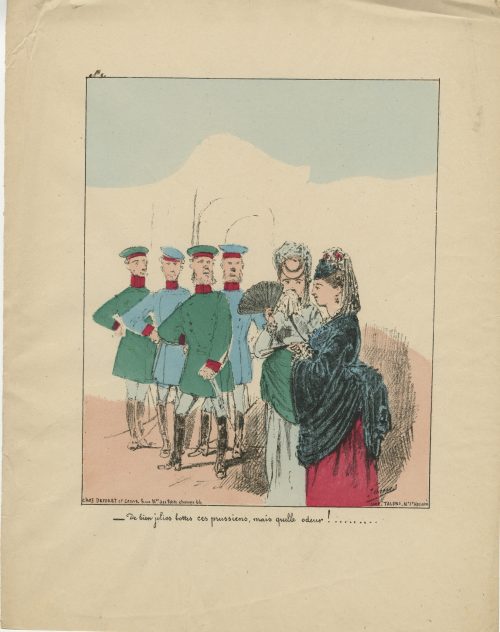 Artist: James (nothing else is known). According to Maurice Quentin-Bouchart (p. 95), this is sheet №2 of only two known caricatures by James except for Collection Wentzell (publisher) of 14 sheets. Text: De bien jolies bottes, ces Prussiens, mais quelle odeur!..... [What beautiful boots these Prussians have, but what an odour!.....] Two women from the bourgeoisie stand in front of a line of Prussian officers. One covers her nose with a handkerchief and hides what she is saying from the men with her fan.
Artist: James (nothing else is known). According to Maurice Quentin-Bouchart (p. 95), this is sheet №2 of only two known caricatures by James except for Collection Wentzell (publisher) of 14 sheets. Text: De bien jolies bottes, ces Prussiens, mais quelle odeur!..... [What beautiful boots these Prussians have, but what an odour!.....] Two women from the bourgeoisie stand in front of a line of Prussian officers. One covers her nose with a handkerchief and hides what she is saying from the men with her fan.


